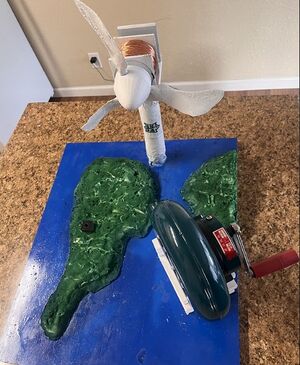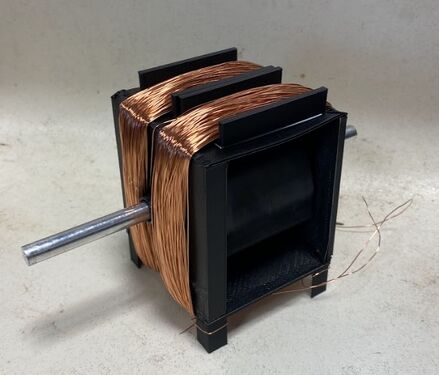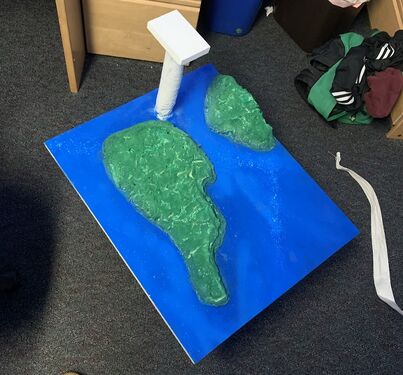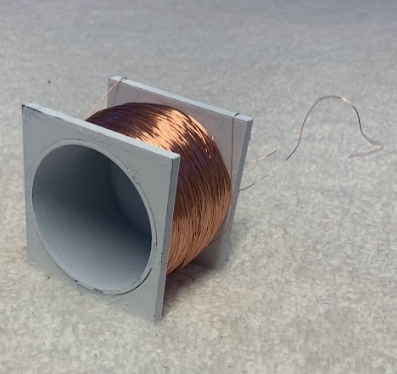
Team OZLC's Human-Powered Wind Energy Demo is an interactive display featuring a hand crank fan, model wind turbine, and offshore-themed baseboard. It was designed and implemented during Cal Poly Humboldt's Spring 2024 semester. The purpose of the demo is to provide School of Engineering faculty with an educational method of engaging with students at tabling events such as the annual Spring Preview.
Background[edit | edit source]
This project is for the 2024 Spring course of Engineering 205, Introduction to Design, taught by Lonny Grafman and Qualla Ketchum. Our client is Dr. Eileen Cashman, head of the School of Engineering at California Polytechnic University, Humboldt. Several times per year Dr. Cashman and other faculty attend tabling events such as the Spring Preview to showcase the engineering majors at Humboldt; however, they lack an engaging way for students to learn about the program. Their tables are typically empty aside from fliers. The solution is to design and implement an interactive display representing Humboldt’s engineering program for prospective students to use at these events. Team OZLC is assigned to the topic “Human Power Demo.”
Problem statement[edit | edit source]
The objective of Team OZLC’s Human Power Demo project is to design, construct, and implement an interactive display relating to human power that previews and highlights Cal Poly Humboldt’s engineering program. The goal is to provide the School of Engineering with a way to spark potential students’ interests at tabling events through an engaging preview of what they can expect to learn here.
Criteria[edit | edit source]
The success of the Human Power Demo project can be quantified using the criteria and corresponding constraints listed in the table below. These were reviewed and weighted by the client, Eileen Cashman.
| Criteria | Description | Weight (1-10) |
|---|---|---|
| Cost | Under $500 ($200 from client and $75 from each group member) | 5 |
| Portability and Setup | Can be moved and assembled easily by one or two people | 8 |
| Longevity | Can be easily repaired when necessary and lasts at least ten uses | 8 |
| Engagement | Intuitive to use and easily recognizable as an engineering demo | 10 |
| Educational Value | Showcases key topics and program highlights of Cal Poly Humboldt Engineering | 9 |
Prototyping[edit | edit source]
Team OZLC cycled through several different project ideas during the prototyping process. The high striker game (shown in the first image) was the original project plan; however, as understanding of the client's needs evolved, it was ultimately scrapped due to its low educational value. The rest of the images depict the process of prototyping the final product, the Human-Powered Wind Energy Demo, which has a better balance of education and engagement.
- Prototyping process
-
Scaled-down popsicle stick prototype of the High Striker Game, the first project solution that was later changed
-
Hand-crank fan, the interactive component of the second and final project solution (the wind energy demo)
-
3D-printed turbine blades (right) and disk bases of the first motor prototype (left)
-
Second motor prototype with a 3D printed base wrapped in copper wire and a rotating magnetic centerpiece connected to metal bar
-
Painted turbine blades attached to the final motor design via a spinning metal bar
-
Hand-crank generator, completed wind turbine, and motor (all outlined in red for visibility) placed on a wooden board, soon to be attached

Final product[edit | edit source]
The Human-Powered Wind Energy Demo is a tabletop display that demonstrates how turbines convert wind and mechanical movement into electricity. The hand crank wind generator (or hand crank fan) is the base component of the project. As it is spun, the fan produces wind that propels the turbine blades. The motor attached to the turbine generates an electric current from the rotation (see section 5.1.3). However, due to the demo’s small size, it does not produce enough power to feasibly utilize.
Originally the motor was planned to illuminate a small LED, but based on the testing results further described in 5.5, the light was not included in the final solution. A small 3D printed house is located on the baseboard’s island for visual purposes so that users can imagine how the offshore turbines might one day power homes in Humboldt.
Prioritizing a point positive design, the hand crank fan is mounted to the front of the display so that there is only one obvious way to interact with the demo. The model turbine is painted white while the fan handle (the interactive piece) is left red, further emphasizing the point-positive design. The white turbine also makes the project more easily recognizable so that anyone approaching the table can intuitively interact with it.
Construction[edit | edit source]
This gallery visualizes and briefly describes each stage of constructing the Human-Powered Wind Energy Demo.
- Construction process
-
Attach ceramic bearings to the metal rod; this will be used to connect the turbine blades to the motor
-
Slot the 3D-printed turbine blades into their centerpiece, paint them white, and connect to the metal rod
-
Prepare the wooden baseboard by cutting an opening for the turbine shaft, made from recycled PVC pipe, and gluing it in place
-
Paint the baseboard blue and use green spray foam to create island-like decorations; glue a wooden block to the top of the turbine shaft and paint white
-
3D print the motor base, paint white, and wrap with copper wire
-
3D print the spinning motor component and embed small magnets
-
Connect the metal rod preattached to the turbine blades through the motor base and centerpiece; glue motor base to the wooden block atop of the turbine shaft
-
Use wooden blocks to create a platform that angles the hand crank fan towards the turbine blades; zip-tie or glue fan to the platform and paint white
-
Final product!
Video instructions[edit | edit source]
Bill of materials[edit | edit source]
Team OZLC spent a total of $161 on the Human-Powered Wind Energy Demo on all the various components. This was under budget and can be refunded by the School of Engineering.
| Component | Cost |
|---|---|
| Hand Crank Fan | $28.00 |
| Metal Rod | $8.00 |
| Ceramic Bearings x 2 | $29.00 |
| Magnets | $3.00 |
| Paint & Spray Foam | $30.00 |
| Copper Wire | $10.00 |
| Wooden Board | $53.00 |
| Total Project Cost | $161 |
Operation[edit | edit source]
The Human-Powered Wind Energy Demo, being an interactive display deigned with high school students in mind, is as intuitive to use as possible. The steps to operate it are described below.
Maintenance[edit | edit source]
The Human-Powered Wind Energy Demo will require light maintenance an estimate of once per year. This may include re-lubing the fan gears, cleaning the bearings, or reassembling any parts that have come loose. The Demo isn't particularly complicated or delicate, so it doesn't require someone with engineering knowledge for these repairs.
Maintenance schedule[edit | edit source]
- Yearly
- Re-lube spinning components: lubricate metal bar and crank fan gears if needed
- Clean bearings: wipe or spray dust and debris out from the bearings and connection points
- Reassembly from storage: glue or tape down components that have loosened from the board
Conclusion[edit | edit source]
Testing results[edit | edit source]
The original plan was for the motor to generate enough electricity to illuminate the small LED to more clearly demonstrate how wind energy works. However, Team OZLC's final testing results found that it could not produce enough of a current to power the light. The turbine requires significantly more rotation speed (and therefore wind) in order to generate a useful amount of energy.
The hand crank fan still creates enough wind to spin the blades a visually satisfying amount. Even without a functioning motor, the Human-Powered Wind Energy Demo meets all the client's criteria and provides an interactive display involving human power and wind energy.
Discussion[edit | edit source]
The fact that Team OZLC's demo couldn't produce enough electricity to power an LED proves the necessity of large offshore wind farms. The hand crank fan, which generated a decent amount of wind force, was unable to spin the turbine blades fast enough. This demonstrates the sheer force of wind required to cause a useful amount of rotation; a force that is readily found offshore. The model turbine was also simply too small to produce a viable amount electricity from its rotational energy. The staggering size of offshore turbines makes sense because of this concept.
Lessons learned[edit | edit source]
The overarching lesson learned was how to use the engineering design process to research, brainstorm, plan, document, prototype, test, and implement a client-based project. Team OZLC learned about basic woodworking, electrical components, and technical writing. Communication between team members and our client was another valuable skill acquired. In the future, what the team will do differently is reach out to different professors ahead of time to discuss technical-heavy construction components such as motors. This way, the final solution will have a better chance of working out the way they're intended, and the results will be more satisfying.
Next steps[edit | edit source]
Team OZLC is finished with the Human-Powered Wind Energy Demo now that the 2024 Spring semester has ended. However, the logical next step for the project would be to revisit the motor and attempt to generate enough electricity to power an LED as originally intended. For now, the demo can be used by the School of Engineering at tabling events to engage with future engineering students. Maybe those students will one day figure out how to modify the demo's motor!
Troubleshooting[edit | edit source]
| Problem | Suggestion |
|---|---|
| Fan isn't generating enough wind | Tighten handle screws and lubricate gears |
| Turbine blades aren't spinning | Adjust tilt of blades by rotating them in their sockets, testing the fan, and repeating until the angle allows for maximum spin |
Team[edit | edit source]
References[edit | edit source]
















